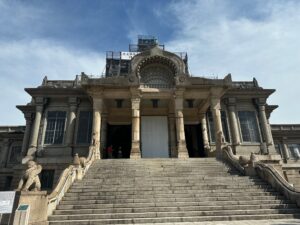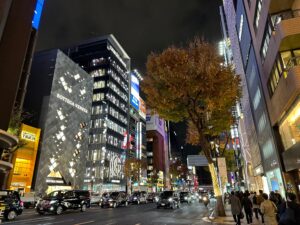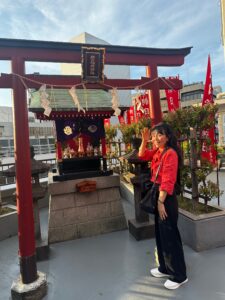
Explore Japanese Spirituality, Hidden Shrines, and Local Culture
Private Tour | 1–4 Guests | 3 Hours | English Guided
Tour Overview
Step off the beaten path and into the spiritual heart of Tokyo. This private 3-hour walking tour connects you with the deep roots of Japanese faith, food, and everyday culture — from sacred temples and hidden shrines to alleyways known only to locals.
Led by Harumi, a nationally licensed guide and former university professor, this experience offers insights into how Buddhism and Shinto beliefs have shaped Japan’s history and daily life.
Whether you’re interested in spirituality, Japanese aesthetics, or authentic local culture, this tour offers something unique.
Highlights
- Meditation and spiritual insights at Tsukiji Hongwanji Temple
- Discover Kabuki-za Theatre, the home of traditional Japanese performing arts
- Explore Ginza’s back alleys and modern luxuries
- Visit three hidden Shinto shrines tucked inside Tokyo’s glamorous district
- Enjoy fresh sushi lunch at a local favorite in Tsukiji
- Private, slow-paced tour tailored to your interest
- Guided in English (Conversational Spanish also available)
Tour Schedule
- 9:00 AM – Meet at Tsukiji Hongwanji Temple
Begin with a short meditation and learn how Buddhism shapes Japanese values and daily life. - 9:40 AM – Walk through Tsukiji Market
Stroll local streets where chefs and neighbors shop, avoiding the tourist traps. - 10:10 AM – Visit Kabuki-za Theatre
Learn the history of Kabuki, its cultural significance, and the unique architecture of the current building. - 10:30 AM – Explore Ginza
Dive into Ginza’s dual identity — its luxurious main streets and quiet back alleys that hold deep spiritual stories. - Shrine Visits Include:
- Asahi Inari Shrine: A hidden guardian in the urban jungle
- Shusse-dō on Mitsukoshi rooftop: Walk the path of career success
- Toyoiwa Inari Shrine: Tucked into a backstreet, filled with quiet mystery
Meet Your Guide – Harumi
- Nationally licensed guide (Japan Government Certified)
- Former university professor with deep knowledge of Japanese culture, religion, and history
- Tsukiji resident — offering a true local’s perspective
- Fluent in English, with conversational Spanish available
- Passionate about showing how Japanese spirituality connects to everyday life
Tour Price (per group)
- 1 person: ¥13,500
- 2 people: ¥17,100
- 3 people: ¥20,700
- 4 people: ¥24,300
Payment: Credit card only
Reservation & Inquiries:
Cancellation Policy
- Free cancellation up to 3 days before the tour
- 50% charge for cancellations 2 to 1 day before
- 100% charge for same-day cancellations or no-shows
Note
This tour is a walking experience and operates rain or shine. Please wear comfortable shoes and weather-appropriate clothing.
Contact Form
Contact me, I’ll respond you as soon as possible.
[About the area]
Cultural and Spiritual Significance of Tsukiji and Ginza
Tsukiji Hongwanji Temple: A Gateway to Japanese Spirituality
Located in the heart of Tokyo, Tsukiji Hongwanji is a Buddhist temple with a unique architectural style inspired by ancient Indian design. Originally established in the early 17th century, it was rebuilt after the Great Kanto Earthquake in 1934. The temple belongs to the Jodo Shinshu school of Pure Land Buddhism, which emphasizes faith in Amida Buddha—the Buddha of Infinite Light and Compassion. This belief has deeply influenced the everyday spirituality of Japanese people, offering comfort, humility, and a path to peaceful living.
Before beginning the tour, visitors are invited to experience a moment of silence or meditation, connecting with the enduring spiritual values that shape Japanese culture.

Tsukiji Honganji temple
Kabuki-za: A Living Legacy of Edo Culture
Located in Higashi-Ginza, Kabuki-za is the principal theater for kabuki, Japan’s traditional form of dramatic performance that combines music, dance, and elaborate costumes. Founded in 1889, Kabuki-za stands as a symbol of the refined yet lively entertainment culture of Edo (now Tokyo).
Though the current structure was rebuilt in 2013 with modern technology, the façade faithfully preserves the original Japanese architectural style. The theater continues to host full-day performances in rotating acts, attracting both enthusiasts and curious visitors from around the world.
A Glimpse into Edo-Era Entertainment
Kabuki originated in the early 17th century, reflecting the tastes and lifestyles of common townspeople during the Edo period. It often featured dramatic stories of love, revenge, samurai honor, and supernatural events. What set kabuki apart were its stylized movements, make-up (kumadori), and the way it captured the emotions and imagination of everyday people.
In the Edo period, going to a kabuki show wasn’t just about the performance—it was a social experience. Theaters were surrounded by teahouses, food stalls, and shops, making them lively hubs of popular culture. The audience included merchants, artisans, and even samurai, all brought together by a shared love for drama and spectacle.
Why It Matters Today
Kabuki-za is not just a theater—it is a cultural institution that preserves the aesthetics, values, and humor of historical Japan. Visiting the theater today, even just from the outside, offers a deep sense of connection to the spirit of Edo and the enduring art of Japanese storytelling.

Kabukiza theater
Ginza: The Cultural and Commercial Heart of Modern Japan
Ginza is not only Japan’s most iconic shopping district—it is the stage upon which the story of modern Japan was written. Once the site of the Edo-period silver mint (hence the name “Ginza,” meaning “silver seat”), the area became a symbol of Westernization and progress in the Meiji era. Today, Ginza represents the blending of tradition and innovation, with its luxury boutiques standing beside centuries-old shrines hidden in quiet alleyways.
As the saying goes, “If you want to see the essence of Japan, go to Ginza.” The district is more than fashion and fine dining; it reflects the resilience, elegance, and spirituality of Japan’s cultural evolution.

Ginza
Inari Faith in Ginza – A Hidden Spiritual Tradition
What is Inari?
Inari is a revered Shinto deity associated with rice, prosperity, and protection. While originally worshipped by farmers for good harvests, Inari gradually became the guardian deity for merchants, artisans, and urban dwellers, especially in the Edo period (1603–1868).
Why Are There So Many Inari Shrines in Ginza?
During the Edo period, Ginza was not only the site of the silver coin mint (the “Gin-za”) but also a bustling center of commerce and craftsmanship. Fires and epidemics were common, so residents built small Inari shrines to pray for protection, prosperity, and good fortune. These shrines were often tucked away in alleyways or behind buildings, where locals would offer prayers daily.
Even today, hidden Inari shrines remain scattered across Ginza, offering a spiritual counterpoint to its glamorous modern image.
Key Inari Shrines in Ginza:
- Asahi Inari Shrine (a holy place of anime “Weathering With You” or “Tenki no ko”) : A quiet, humble shrine nestled in a back alley, loved by locals and believed to bless performers and artists.
- Shusse Jizo (on the rooftop of Mitsukoshi Ginza): Dedicated to success and career advancement. A rare example of a shrine located on top of a department store, reflecting how tradition and modernity coexist in Japan.
- Toyoiwa Inari Shrine: Located in a small alley in Ginza 8-chome, this shrine is known for granting wishes, especially related to love, safe childbirth, and personal growth.
Cultural Significance
Visiting these shrines reveals an often-overlooked spiritual layer of Ginza, connecting the modern city with the beliefs and practices of Edo-period townspeople. It’s a journey into the soul of Tokyo, hidden in plain sight.

Asahi Inari shrine
Tsukiji & Ginza Walking Tour 050-7109-3640